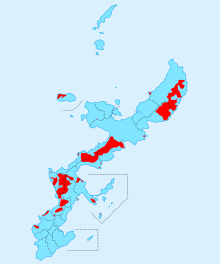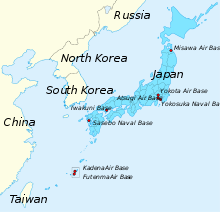Yankee, Go Home!
After the Japanese government surrendered to the Americans and their allies in 1945, the U.S. military occupied the Japanese home islands and ruled the nation for several years. In due course, however, Japan’s situation was normalized, and, moreover, in 1946 the Japanese adopted a new constitution that renounced war as an instrument of national policy:
CHAPTER II: RENUNCIATION OF WAR
Article 9:
Aspiring sincerely to an international peace based on justice and order, the Japanese people forever renounce war as a sovereign right of the nation and the threat or use of force as means of settling international disputes. 2) In order to accomplish the aim of the preceding paragraph, land, sea, and air forces, as well as other war potential, will never be maintained. The right of belligerency of the state will not be recognized.
At that point, Japan no longer represented a threat, or even a potential threat, to the United States, apart from the threat that developed later that the Japanese would sell American consumers superior automobiles and consumer electronics, among other things.
Yet the Yankees never left Japan. Their military installations remain there today, sixty-six years after Japan’s surrender. These bases are staffed by some 36,000 U.S. military personnel and more than 5,000 American civilians employed by the U.S. Department of Defense.
Major U.S. Military Bases in Japan
About three-quarters of the U.S. military bases in Japan are located on the islands of Okinawa, where the fiercest battle of the Pacific war occurred in the spring of 1945, causing horrendous losses on both sides, including many thousands of civilian deaths, and the destruction of about 90 percent of the islands’ buildings.
U.S. Military Bases in Okinawa

As if the wartime devastation were not enough, the American military personnel on Okinawa since 1945 have made themselves a chronic nuisance to the local populace, perpetrating crimes that range from automobile-related incidents, such as hit and run, to assaults and rapes. U.S. aircraft sometimes crash into civilian areas. Most Okinawans devoutly desire that these unwelcome, seemingly permanent American occupiers would get out.
And well they should; indeed, they should have done so a long time ago.
Yet, many well-placed U.S. officials and public-opinion molders have insisted, and continue to insist, that even if Japan does not threaten the United States, maintenance of U.S. forces in Japan serves to protect Americans from other threats, such as that posed by China. However, the idea that the Chinese, who rely on Americans to purchase a large share of their exports and who currently own more than $1 trillion of U.S. Treasury securities, would wish to attack the United States militarily seems more preposterous by the day. This far-fetched tale is, however, the sort of story that neocons enjoy telling their children at bedtime, when the little tykes have tired of the one about the impending Iranian nuclear strike.
Keeping U.S. military forces in Japan, like keeping them nearly everywhere else they are kept around the world, serves primarily to preserve the global empire of bases that gives U.S. generals and admirals plush commands and U.S. policymakers at the Pentagon and the State Department something to toy with when they are running out of ideas about how to make the world poorer and more dangerous. At the same time, though, the U.S. government, which must borrow 40 percent of the dollars it spends and whose once-riskless securities have begun the descent toward junk status, must expend hundreds of billions every year to maintain its imperial forces abroad. Even if these foreign bases had a genuine rationale, which for the most part they do not, the simple fact is that the government can no longer afford to maintain them.
The solution ought to be obvious: Yankee, go home!
